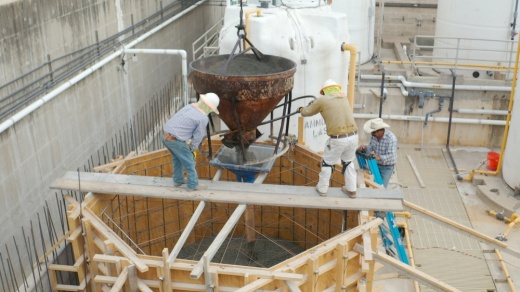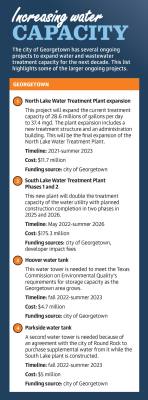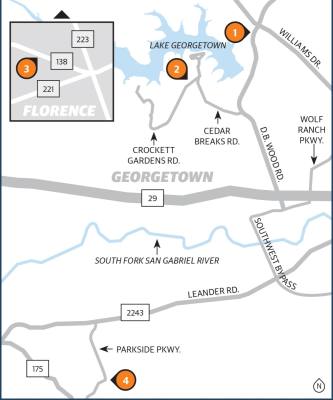Georgetown issued Phase 1 of its water contingency plan in March and quickly moved into Phase 2 in June, forcing residents to adhere to a once-weekly watering schedule. However, Georgetown Director of Water Utilities Chelsea Solomon said the department has initiatives year-round to encourage conservation.
Brad Brunett, regional manager for the Brazos River Authority Lower and Central Basins, said water is a finite resource, and while the 11-source area system—which includes three BRA-owned reservoirs and eight Army Corps of Engineers reservoirs—is 80% full, communities still need to do what they can to conserve water and ensure capacity remains in the coming months and years.
Brunett said the city of Georgetown has contracted water with the BRA since the 1980s. Georgetown receives groundwater from Lake Georgetown and Lake Stillhouse. However, the city manages its own usage, rates and capital improvement projects.
Additionally, Solomon said the water utility is working on several projects that will ensure it can meet demand in the future.
Projections show Georgetown’s maximum daily demand would exceed its production capacity in both 2023 and 2024. However, the average daily demand remains below the production capacity through 2030.
“Georgetown is arguably the fastest growing of all our customers, but we ask all our customers to be mindful of their water usage during [periods of high usage],” Brunett said.
Meeting capacity
More than 5,000 people moved to Georgetown in fiscal year 2020-21, bringing the city’s overall population to 75,420, data from the U.S. Census Bureau shows.
As a result, the city added about 5,000 new water utility customers, further illustrating the need for improvements to the water department’s infrastructure, Solomon said.
Solomon said the department is planning to account for more than 53,000 customers in 2023.
To keep up with growth, Georgetown broke ground on the South Lake Water Treatment Plant in May. This new treatment center will double the treatment capacity of the water utility with construction done in two phases, which are expected to be complete from 2025-26.
The project in its entirety includes the water treatment facility as well as a raw water intake point on Lake Georgetown that draws water from the lake and a transmission line for that water.
The city is also working on a North Lake Water Treatment Plant expansion, an $11.7 million project that will increase plant capacity by 30% to 37.4 million gallons per day. The project started in 2021 and is expected to be complete by summer 2023.
Georgetown City Council also approved a $10 million contract with Landmark Structures I L.P. in July for the construction of two water towers for additional storage.
Georgetown Systems Engineering Director Wesley Wright said a 2 million-gallon water tank located south of SH 138 and east of US 183 is needed to meet the Texas Commission on Environmental Quality’s requirements as the area grows.
Wright said a 1.5 million-gallon tower located east of Ronald Reagan Boulevard and south of RM 2243 is being built in conjunction with the city of Round Rock to expand the Georgetown water system during peak demand while South Lake is constructed and brought into service.
“The Parkside elevated storage tank will increase our water storage capacity on the southwest side of our water service area,” Georgetown Communications Manager Keith Hutchinson said. “This storage capacity, in addition to an existing nearby connection to a city of Round Rock water main, will increase our system capacity during peak demand in the summer.”
Both tanks are expected to be completed and in use by summer 2024.
“Without our current expansion projects, the city’s watering restrictions would be intense,” Solomon said. “We would not be able to support our current customers and their needs, let alone future residents.”
Campaigning for conservation
While projects to increase Georgetown’s water supply are underway, the city and local community groups have implemented creative campaigns in an effort to conserve water.
Solomon said Georgetown’s current and future water capacity will meet demand through 2052. With additional conservation measures, the city can meet demand through 2057.
Mallory Tallas, Georgetown marketing program coordinator, said the city’s water conservation team will hold its inaugural painted rain barrel project at the Georgetown Arts and Culture Board’s Autumn Art Stroll as well as an Imagine a Day without Water event in October.
“The barrels will be displayed around city facilities and downtown businesses before and during the South Main Arts Festival,” Tallas said. “All painted barrels will be available to purchase at a silent auction that will run through the course of the Autumn Art Stroll and South Main Arts Festival.”
A $125 minimum bid will be placed on all barrels with all proceeds being donated to conservation education efforts in GISD schools.
Additionally, Imagine a Day Without Water is a national education campaign that brings hundreds of stakeholders together to highlight how water is essential, invaluable and in need of investment.
Tallas said the city can implement a variety of activities during its participation, including social media polls, city proclamations and sharing deeper insights into the city’s water treatment process.
John Shideler, Sun City’s Water Matters group chair, said these conservation campaigns must result in resident action as keeping residential water usage at a moderate level is crucial for the community’s future.
The organization and the city collaborated in July to help promote the once-weekly watering schedule among other small-scale irrigation adjustments in Sun City.
“There is only so much water that is available for residents,” Shideler said. “Neighborhoods must recognize the importance of conservation and should enforce rules and regulations of conservation. Every drop counts.”










